Every year, InfoCorp (an industry analysis company) holds a technology forum at the Silverado resort in Napa, California. I was foolish enough to volunteer to speak, and so I had to prepare this speech which I gave with slides. I'm including this for two reasons. First, this is the most coherent exposition in print of Autodesk's strategy at the time. Second, preparing and delivering this speech, on top of everything else that happened in early 1986, was one of the items that prompted me to start seriously planning to hand the job of president on to somebody better suited to do it.
The machine age began to come to an end with the invention of the first programmable computer.
We often forget that the word ``technology'' comes from the same root as
``technique''.![]() It has nothing to do with machinery, it's how humans
apply their minds to solving problems.
It has nothing to do with machinery, it's how humans
apply their minds to solving problems.
The general purpose computer is a tool which allows pure technique in the form of algorithms to be applied to problem solving. This is the central fact of the computer revolution.
Since the advent of the low cost microprocessor, we have seen the replacement, on an accelerating basis, of special purpose machinery (whether mechanical or electronic) with general purpose computing elements. Examination of a 1970 vintage teletype beside a contemporary printing computer terminal will illustrate the extent of this revolution.
Today, as the designers of the complex machinery of the past retire, the skills which created such exquisite machines as mechanical calculators which could divide are moving from practice to history. Designers entering the workforce often view the achievements of their seniors, accomplished without computing elements, the way our civilisation views the building of the pyramids.
So what in the world does any of this stuff have to do with PC's in the engineering world, or with PC CAD?
In every area general purpose computers have entered, they have been forced to educate people that what was once a machine is now simply a piece of software.
Remember when computers looked like computers?
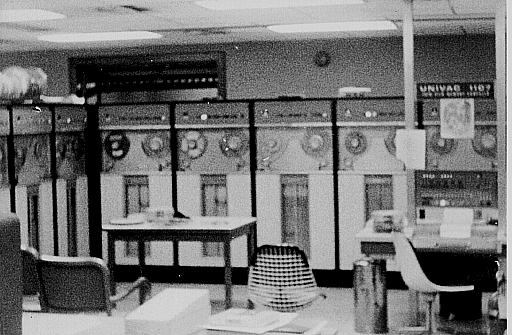
This is the first computer I ever used.![]() By the standards of
the early 1960's, it was a supercomputer.
By the standards of
the early 1960's, it was a supercomputer.
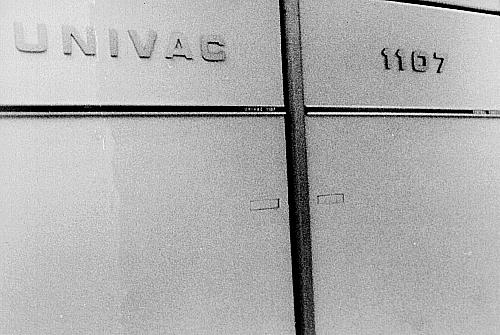
It had 256 thousand bytes of 8 microsecond core memory.
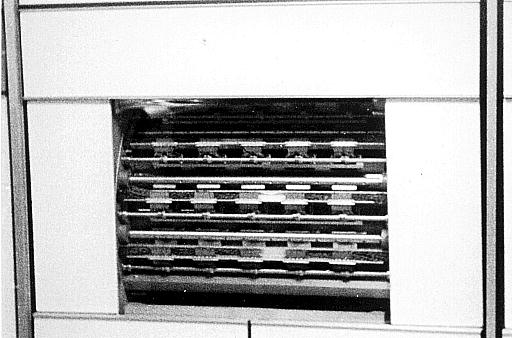
Its magnetic drums provided 6 megabytes of secondary storage.
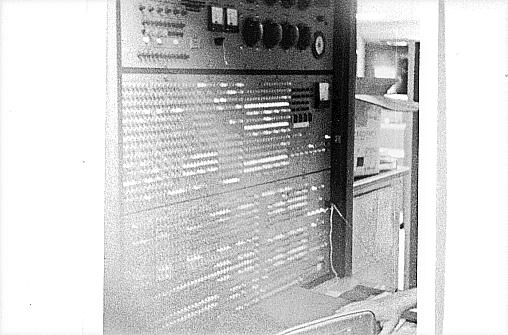
It added two 36 bit numbers in 4 microseconds.

It performed single precision floating point adds in hardware in 14 microseconds.
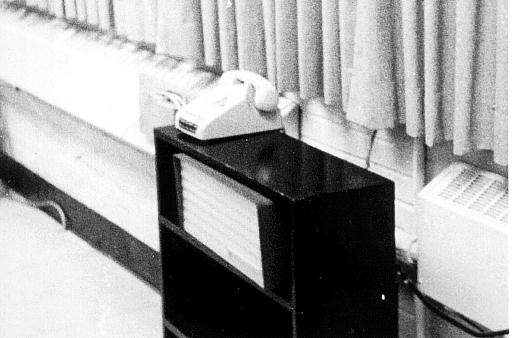
It communicated with remote terminals at 2400 bits per second.
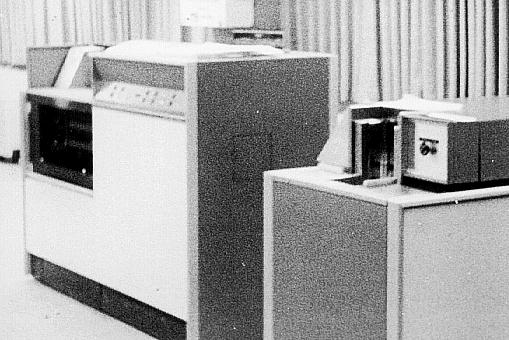
It served a single user at a time, with high speed batch processing.

And laser technology was on the verge of revolutionising data storage.

This computer performed all the engineering, scientific, and software development computation for a university with a graduate and undergraduate population of over 2000. It was used for finite element analysis, fluid dynamics, particle physics, compiler and operating system development: virtually every field of science and engineering. It was retired in 1968.
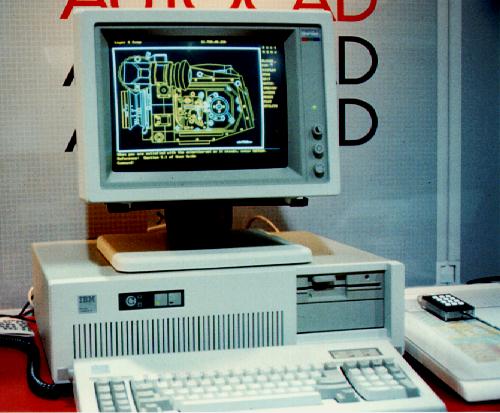
This is the computer I'm using today--an IBM PC/AT, the exemplar of the PC in technical applications.
It has 3 and three quarter megabytes of 150 nanosecond RAM.
It has twenty megabytes of disc storage.
It does 32 bit adds in 2.3 microseconds.
It provides both single and double precision floating point in hardware, doing single floating adds in 20 microseconds.
It communicates with other computers on a network at ten million bits per second.
And laser technology is on the verge of revolutionising data storage.
It serves a single user at a time, me. It spends more than half of its time turned off, and a majority of its time while on waiting for me to type on the keyboard.
This computer, a PC, has 14 times the main memory, and three times the disc storage of the 1960's mainframe. Its memory is 53 times faster. The processor is 3.4 times faster for integer calculations, and .7 as fast for floating point. For double precision floating point, the heart and soul of scientific and engineering work, the PC is over 4 times faster.
So it isn't just hyperbole when we talk about having a room sized mainframe's power on our desks. For less than the price of a car, we can own a computer more powerful in every way than the mainframes on which most of the key engineering applications used today were written.
It is these statistics which show how utterly absurd it is when somebody pronounces that some job or other will never be done on a PC.
The confluence of these two trends; the displacement of special purpose machines with general purpose processors, and the ongoing giddy decline in the price one must pay for computing power has led to the development of the general purpose workstation.
In the mid 1970's, everybody thought of a word processor as a machine. It was an expensive box, bought from a word processing company primarily by large corporations, who could pay the price to obtain the productivity gains such a machine delivered. Virtually beneath the noses of the word processing vendors, people started selling word processing programs which ran on PCs, those funny ``hobby computers'' that strange people bought and played with. Before long, the use of general purpose PCs with word processing software dwarfed dedicated word processors, even in the markets where word processors were strong. Note that they did not supplant word processors--companies continue to buy word processors for full-time typists, and word processors provide services to these operators which PC programs do not currently provide. But most people write as part of their job, not full time. They need an easy to learn and use tool which is one of a collection of tools they run on a personal workstation.
In 1982, my company started selling a computer aided drafting and design program which ran on PCs. The conventional wisdom, as represented by those venture capitalists and analysts we could get to talk to us was:
Well, we didn't have anything else to do, so we just went ahead and tried anyway. To date, we've sold in excess of forty thousand CAD packages for PCs. To put this number in perspective, it is on the order of twice the number of workstations of the most widely used mainframe CAD system.
Nobody can afford to discount PC CAD and PC engineering applications today. Let me give you some statistics about AutoCAD, the program I sell. I'm using our program as an example because I know the numbers for it; there are other PC-based engineering applications with similar statistics.
The source code for AutoCAD is in excess of 200,000 lines of
C.![]() The
program is well in excess of a megabyte; programming tricks from the
1960s allow it to run in much smaller machines. Today, it embodies
over 70 man-years of development. It is being enhanced at the rate of
over 20 man years per elapsed year. It runs on over 30 machines,
supports in excess of 120 graphic peripherals, and operates compatibly
on MS-DOS, Unix on the Sun and Apollo workstations, AIX on the IBM RT
PC, and VMS on the VaxStation II.
The
program is well in excess of a megabyte; programming tricks from the
1960s allow it to run in much smaller machines. Today, it embodies
over 70 man-years of development. It is being enhanced at the rate of
over 20 man years per elapsed year. It runs on over 30 machines,
supports in excess of 120 graphic peripherals, and operates compatibly
on MS-DOS, Unix on the Sun and Apollo workstations, AIX on the IBM RT
PC, and VMS on the VaxStation II.
Over 150 third party application packages have been interfaced to AutoCAD. These include structural analysis, bill of material extraction and job costing, pipe stress, architectural design, numerical controlled machine programming, municipal mapping, surveying, printed circuit autorouting, and even football play diagraming and theatrical lighting design.
AutoCAD may be used as a standalone application package, or it may be programmed for specialised applications. We have integrated the LISP language into AutoCAD, allowing users to extend the system for their own jobs.
Over 600 educational institutions teach drafting and design with AutoCAD. AutoCAD is available in English, French, German, Swedish, Italian, Japanese and Spanish language editions. Translators are available which allow AutoCAD to interchange drawings with most major mainframe CAD systems.
By virtually any measure you choose to apply, lines of code, internal complexity, investment in development, ongoing development commitment, open architecture, third party support, migration to multiple hardware platforms and operating systems, and computing power consumed by the package, AutoCAD is mainframe software. So why do we choose to sell it on PCs?
Because that's where the money is.
It seems like if you stand on a street corner in Silicon Valley and hand somebody a $20 bill, he runs off to build an engineering workstation. On everybody's mind is the refrain, what will become the engineering workstation of the 80's and 90's? Chip makers vie to position their 32 bit processor as the heart of the lucrative engineering workstation market.
The numbers tell another story. Today, for every 32 bit engineering workstation in the world, there are more than one hundred 16 bit MS-DOS machines. It's news when a major company selects one of the workstation vendors to provide 200 workstations for an engineering facility. It's routine when their purchasing arm orders another thousand PCs to equip another department. They are, after all, just PCs.
As a software supplier, I can't help but notice that those who sell software on the 32 bit workstations don't get a hundred times as much per copy of their software as those of us who sell on PCs get for ours.
Let me return for a moment then, to the theme of this talk...PCs invading the engineering market. I'd like to retitle it at this point...to PCs infiltrating the engineering market. I'll explain how this is happening in a moment.
First of all, please keep in mind that only a small percentage of the engineering and scientific work in this country is done in the large companies. I'm fascinated by how many companies focus on the Fortune 1000 to the exclusion of the rest of the market. Marketing to the Fortune 1000 has its advantages; it's a clearly defined prospect list, heavily researched, and generally sellable from the top down. But in many cases it's only a small fraction of the market.
There are over 600,000 manufacturing organisations in this country. Eighty five percent employ ten people or less. The overwhelming percentage of architectural firms employ less than ten people. Even within the largest companies, there are sales offices, project groups, and application engineering arms which are operating as small autonomous entities.
Most drafting and design done today is not being done on CAD systems, it's being done by hand. Most mechanical parts are not being designed on mainframes or engineering workstations, they're being designed on paper, or by rule of thumb. Only a tiny percentage of the entire building process, from architecture through construction to facility management, involves computers at all. This is the vast untapped market. This is what accounts for the dominance of the PC in engineering applications. Those who ignore it do so at their peril.
An engineer's job embodies many different activities...writing, reading, performing calculations, drawing, interacting with others, and exploring design alternatives. The computer can play a part in all of these parts of the job other than face to face interaction. An ideal engineering workstation, therefore, is one which performs all of these tasks while requiring the least effort to master.
Engineers spend a lot of time writing. They do calculations which in the dark days before microprocessors were done on slide rules. Those in larger organisations access central databases, and may use some form of electronic mail for communication. There is a cheap and effective tool which improves productivity in all of these tasks--the desktop computer. For less than the monthly salary of an engineer, a computer which delivers immediate and measurable gains in output can be placed on his desk. And that's being done today, by the millions.
Don't underestimate the power of a widely distributed tool. If an engineer has a PC on his desk, which may have been purchased, justified, and primarily employed as a word processing station and terminal to the company computer, and has the choice of, for example, doing a drawing on that desktop machine with a PC CAD program, versus signing up for time at the corporate CAD centre, or submitting a sketch to the drafting department for three day turnaround, what will be his decision?
That decision will usually be made based on the engineer's desire to optimise his own productivity. Who cares if doing a drawing on the PC is ten percent slower than using the corporate CAD station...if that ten percent amounts to 6 minutes for a one hour drawing, and you have to wait 2 days for your time on the CAD station, or 3 days for drafting to turn around the drawing, the engineer and his employer is well ahead by using the PC to make the drawing.
Similarly, in the small organisation, the purchase of a PC may have been prompted by the desire to use it as a word processing system, or to keep accounts, or to maintain spreadsheets. The addition of a PC CAD package, or other engineering or scientific analysis package may result in productivity gains in those aspects of the business as well.
In both cases, then, what we're seeing is infiltration, not invasion. The PC is justifiable as a productivity tool in organisations large and small. It is bought to perform the tasks that everybody agrees it does best. Once in place, users discover that they have far more power at their fingertips than they imagined at first, so the PC assumes more and more complex tasks, impinging on those applications oft considered as requiring a ``mainframe'' or ``turnkey system''.
The PC, because it is there, is applied to these more demanding tasks. Users discover that the PC does a fine job performing them, and as the word spreads, the managers of the central data processing and CAD facilities discover that the projected growth in demand for their services is falling below expectations. First, by a small amount, then a larger factor, and finally by so much that somebody is delegated to find out what is going on.
And another organisation discovers the PC as engineering work station.
Every time I give a talk, I always get a question that goes like, ``Do you see the 32 bit machines supplanting the 16 bit machines'', or ``what will the impact of RISC technology be on the workstation market'', or ``will the 80386 cut into the 68000 based market''. I have to answer by saying, ``I don't have any idea and I couldn't care less''.
Except for those who build the machines and those who invest in them, the issue of CPUs and operating systems is of a lot less significance than a lot of people think.
Let's look at the general shape of a workstation as it will exist in a couple of years. It will have a fast processor, delivering at least the power of a VAX 780 on the desktop. It will support an operating system which provides multitasking, and will probably look a lot like UNIX. I include MS-DOS and its derivatives as Unix-like. It will have a high resolution screen, and the software will support a window environment allowing concurrent execution of disparate tasks. The station will be usable as a standalone computer by a user with no previous experience in system administration, and it will be possible to connect the system to others in a network which provides a true distributed file system.
It will provide all of the programming languages in which major applications are written, including C and FORTRAN compilers of high quality. All of the major engineering and scientific application packages will be available to run on it.
And, sad to say for the vendors, it will probably cost a lot less than many of them assume today. More on this later.
Numerous contenders meet, or will soon meet these tests. The software suppliers will put their packages on all of the major contenders' machines. The market will decide who the survivors will be.
The terminology in the computer industry has always been murky. The fact that we don't break out in laughter when we hear such precise nomenclature as ``mid-sized supermini'' and ``mini supercomputer'' indicates just how hard it is to draw lines between the computing resources we have available today.
There is, in fact, far more of a continuum of price performance available in computers today than at any time in the past, and this is largely unappreciated by the buyers and sellers of this equipment alike. At the same time, the emergence of a small number of standard operating systems, languages, user interfaces, and networks has made migration between these machines unprecedentedly easy.
Here are three machines running AutoCAD. The first is the Data /indexData General One General One, a 9 pound laptop portable. The second is a PC/AT. The third is a Sun workstation running Unix. The program functions identically on all of these machines. Data may be moved between them using any of several media.
Only ten years ago, it was taken as commonplace that every computer vendor had its own operating system, data formats, and user interface. Users have demanded that industry standards be adopted to protect their investment in data, programming, and user training. They communicated this demand to the hardware suppliers in the most direct method possible, by choosing to buy only systems which gave them this protection. And the survivors among the suppliers have learned.
Let's look at how distribution of these products is developing. Back in 1983, if saying the words, ``PC Software'' failed to empty a room of venture capitalists, adding ``Retail distribution'' usually did the trick.
But the unavoidable fact is that as the price of computer systems and software falls, and the number and range of customers consequently expands, the way these products reach their users must change. You simply cannot afford to sell a $2500 product to hundreds of thousands of customers with the type of direct sales force and on site support that has been characteristic of the computer industry in the past.
When we started Autodesk, we decided that we would not sell any products directly, but rather pass them through reseller channels. We initially focused on computer manufacturers, who were at the time building software distribution arms and targeting the major companies. Concurrently, we began to build a dealer network to sell our product to users and provide local support. We have seen an ongoing shift in the distribution of our product from a mix dominated by OEM sales to computer manufacturers in 1983 to one today where more than 85% of our product is sold through dealers.
Some people may not take computer dealers very seriously, but in less than four years, they've sold twice as many CAD systems as any of the CAD companies have in two decades.
Who are these dealers? Originally our dealer requirements were fairly low. If you bought two packages and paid COD, you were a dealer. We didn't go through the extensive qualification filtering that some of our competitors did, looking at square feet, location, staffing, service facilities, and so forth. Thank goodness. Some of our most successful resellers were those who wouldn't have been taken seriously by most software vendors. One, for example, was an architect who bought the package for himself and than began to configure systems for other architects. In less than three years, this architect has built a CAD sales, service, and support facility employing 14 people and selling to a wide variety of users.
Today, our dealers are much better qualified and trained. Every one of our more than 1300 dealers is required to have a full time person on staff with a drafting or engineering background. They are required to attend dealer training at our headquarters, and must return yearly for update training in new products and updates to the current product. Dealers must commit to providing direct user support for every package they sell.
Dealers who are successful in selling CAD and engineering applications are hard to characterise. Some specialise in the sale of CAD, while others carry a broad line of products. Our successful resellers include chain computer stores who have taken on CAD as an additional product line. Some focus on sales to one vertical market, such as architects or mechanical engineers, while others sell a basic drawing facility to a wide variety of users.
Further, while the computer retailer is often seen as a storefront selling to individual walk-in customers, many of our resellers have closed major sales with Fortune 1000 companies, government, and education by outreach marketing.
Many software vendors today are bemoaning the poor health of the dealer channel. We hear things said like, ``how viable is a business where all of your resellers are losing money''. Yet many of these companies who express concern for their resellers place their products in mass distribution channels which result in the package being sold mail order at prices at or below the dealer's cost. Is it any wonder that computer dealers don't spend much time mastering, demonstrating, and selling software?
If a software vendor wants to build and support a healthy dealer network, it must resist the temptations which destroy the vitality and profitability of that channel. It must decline to sell through discount channels. It must refuse to skim the cream off the dealer's business by selling direct to larger customers at a discount. And it must provide the training and support to keep the dealer competent to support his customers.
Many of those who said that CAD couldn't be sold through dealers pointed to the extensive user training and support traditionally provided with larger CAD systems. As desktop computers enter the engineering market, other collateral forms of support and training are evolving.
But nobody has as much control over how users come to master a product as the people who designed it. User interface is a distribution issue. If a product is sold for hundreds of thousands of dollars and used by a full time operator, it is reasonable for the vendor to provide a two week training course for the operators, and direct customer assistance.
When we designed AutoCAD, we knew that it would be bought and used primarily by users who had never seen a CAD system before. These first time users required a user interface that led them through the package, and extensive documentation, on line help, and support materials to aid them in getting started. In some ways, a CAD system for a first time, or part time user needs to be more complicated than one used by a full time CAD operator. The CAD operator has learned and invented work-arounds to achieve things the system cannot do directly. In addition, CAD operators usually have a manual drafting background and can always fall back on paper and pencil techniques where the CAD system lacks power.
For example, suppose the user has drawn two circles and wishes to draw a line perpendicular to one and tangent to the second. If the CAD system cannot perform this geometric calculation itself, the casual user is far less likely to know how to do it with construction lines as you did on the drawing board.
There is an aphorism in the electronics business that goes, ``it costs a lot of money to make something cheap''. Well, in the software business it takes a lot of work to make something simple. In order to diffuse these previously specialised tools to communities of users thousands of times as large as before, we have to make major investments in user interface, on-line assistance, and teaching tools.
As a previously specialised tool becomes a widely distributed de facto standard, independent support becomes available to the users. The wise vendor encourages and promotes this. Autodesk has, for example, designated 43 organisations Authorised Training Centres. These centres, many of whom are regular educational institutions, provide direct user training courses, with several offering introductory through advanced courses focusing on specific application areas. By the end of this year, over ten books will be on the market based on AutoCAD. Only a product which generates sales in the tens to hundreds of thousands can economically support these developments.
What we are seeing in distribution then, is a shift from expensive, hard to use products sold directly in small numbers, to cheap, easy to use products sold in vast quantities. The user has access to the same, or better, training and support as before, but provided by a large number of suppliers in an open market, rather than directly from one supplier.
Now let's look a little bit into the future. As guidelines as to what is likely to happen, it's worth remembering a few pieces of what was conventional wisdom in 1983. It's just as true today.
Desktop computers are being sold by the millions. This is a situation unprecedented in the human experience, equivalent to the development of a mass market for music created by the phonograph or for theatre created by motion pictures and television. Those who take advantage of this opportunity will do very well.
Most tasks are done today manually or by something very close. Anybody who thinks that all the productivity tools have been invented hasn't spent much time looking at their workday.
We have made enormous strides in the last five years in making enormously complicated tools usable with no training. This is only way to sell to a mass market.
Far less than one movie in ten is a hit. Far less than one book in ten is a best seller. Why expect any better for software? But there are hit movies and books, and the winners in the software wars will be as enduring.
Picking the end of a trend in progress is one of the most difficult and least profitable activities one can choose to undertake. For forty years, everybody who bet on the price of computing power ceasing to decline has been dead wrong. So while I can't predict whether the PC will become the universal engineering workstation, I firmly believe that whatever ends up occupying that niche will cost less that today's PC. It is instructive, for example, to compare the specifications of the Atari 1040ST, which sells for less than $1000, to those of the proposed ideal engineering workstation of just two years ago.
The customers are a lot smarter than many vendors think. Suppliers who put the power to extend and adapt their products into the hands of their users and resellers unleash the creativity of these people to create products that directly benefit the supplier...and at no cost. Vendors who begrudge others who build successful businesses based on their products stultify those in the best position to make those selfsame products successful.
Find a case in the entire history of computing, where a closed architecture, proprietary system has defeated an open architecture system in the market.
Find a case where you cut the price of something by ten times and don't create a market far more than ten times larger.
Some people are still trying to take a software product and bundle it with hardware and sell it as a turnkey system for one particular job. If you undertake this, remember that you are trying to resell somebody else's hardware in direct competition to the computer manufacturer who made it. Good luck.
The long delayed but finally occurring advent of networks is going to make some major changes in the way people work, and create some major opportunities for software suppliers. Everybody's heard the phrase, ``networks will enormously reduce the need for a large, central mainframe'', and I believe it's true, but managing the kind of distributed database this leads to, and integrating this into an organisation will require solutions to many difficult technical problems that have been inadequately addressed to date.
Engineers do not work on drawings or documents. They work on projects. They communicate with others, and interchange design data at several different levels of abstraction. The computer has much to contribute to the entire process of engineering, and the gains as individual productivity tools begin to work together will be as great as those of the tools themselves.
The PC sector of the business is not a sideshow. It's the main event. This is where the battle for the entry level user is being waged. The software that establishes itself as a standard in the PC market will be carried upward to more powerful hardware as users migrate to their own best point on the price performance curve.
Today, the overwhelming majority of first time CAD users are using PC CAD. The overwhelming percentage of students who are learning CAD are learning on PC CAD.
Users will come to see the workstation hardware itself as little more than an appliance which delivers the productivity gains embodied in software. It will eventually be seen as making no more sense to ask, is a PC right for engineering work than to ask what is the best television for watching cop shows.
And in twenty years, somebody will show a slide of an IBM AT and ask, ``remember when computers looked like computers?''.
Thank you.
Editor: John Walker